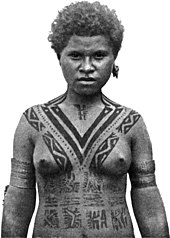Motu people

| Languages | |
|---|---|
| Motu, Tok Pisin, English | |
| Religion | |
| Christianity, traditional beliefs |

The Motu are native inhabitants of Papua New Guinea, living along the southern coastal area of the country. Their indigenous language is also known as Motu, and like several other languages of the region is an Austronesian language. They and the Koitabu people are the original inhabitants and owners of the land on which Port Moresby — the national capital city — stands. The largest Motu village is Hanuabada, northwest of Port Moresby.
History
[edit]Friedrich Ratzel in The History of Mankind[1] in 1896 reported the tattooing in Melanesia. Among the relatively light-skinned Motu he found tattooing in patterns similar to those of Micronesia. He also reported, among the old women, blackening the body with a kind of earth which gives a lustre like black lead. This was said to be a sign of mourning.
Charles Gabriel Seligman came into contact with the Motu, in 1904. He noted that, unlike many of their neighbors in the region, the Motu did not practice exogamy. However, there was significant intermarriage between the coastal Motu and the more inland Koitabu.[2] Every year, they practiced the hiri, when community members made trading voyages through the Gulf of Papua. Women made pottery for sale through the hiri.[3]
American painter Caroline Mytinger visited Motu villages during her voyage along Melanesia in the 1920s, painting native portraits along the way, including the scene of a Motu girl in dancing costume with a local sorceress in Hanuabada village.
Culture
[edit]Despite increased Westernization, the Motu still engage in some traditional practices. These include the value of traditional music and dance, observing the bridewealth and still retaining most of the land rights in the Port Moresby region.[4]
See also
[edit]References
[edit]- ^ Ratzel, Friedrich (1896). "The History of Mankind". London: MacMillan. Archived from www.inquirewithin.biz/history/american_pacific/oceania/melanesian-tattooing.htm the original on July 6, 2011. Retrieved October 21, 2009.
{{cite web}}: Check|url=value (help) - ^ Goddard, Michael (June 2001). "Rethinking Western Motu Descent Groups". Oceania. 71 (4). Retrieved 12 February 2023.
- ^ Seligman, C.G. (1910). The Melanesians of British New Guinea. Cambridge: Cambridge University Press. p. 49.
- ^ Human. Winston, Robert M. L., Wilson, Don E., Smithsonian Institution. (1st American ed.). London: DK Pub. 2004. p. 462. ISBN 0-7566-0520-2.
{{cite book}}: CS1 maint: others (link)
External links
[edit]